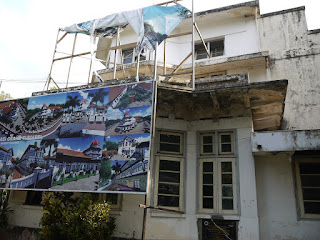Wisma Tumapel: Ghosts of Colonialism in Malang, Indonesia
Andrea Decker/UCR
Immediacy,
so uncomfortably kindred, in the tropical land, to the sensations of twilight,
and jungle, and blurred edges, was to be avoided – no touching across the
line, no warm shadows.
–Rudolf
Mrázek, Engineers of Happy Land
"So,
you love ghost stories, but you don't believe in ghosts?" asked Ardhana,
my Indonesian instructor, in Indonesian.
I laughed.
"I think you'll find that's true for many students from the USA. We love
the stories, the excitement." I was no stranger to Indonesian ghosts; at
this point, I'd studied twice at the State University of Malang. Another of my
teachers, Niken, was a ghost enthusiast who had even named a campus ghost after
me because of the ghost's pale skin, blond hair, and long dress.
 |
| Photo courtesy of Malangonline.com |
Somewhat
mystified, but an ardent ghost fan herself, Ardhana was thrilled when my language
class enthusiastically voiced desire to go to the most haunted places in Malang,
East Java. Given the nature of my ghost namesake, I should not have been
surprised to find out that the top three haunted locations in Malang were all
Dutch colonial buildings near the historic city center.
Much as
Bandung served as an escape for the Dutch from the heavy heat of Batavia (now
Jakarta), Malang was a cool mountain refuge near Surabaya. According to the
tourist narrative, Wisma Tumapel first served as a hotel for the Dutch, built
about 1928, with at least two stories, spacious halls, Dutch-style toilets and
plumbing, and a maze of an interior. In 1944, the Japanese occupied Malang and
used Wisma Tumapel as an administrative building. In 1950, the hotel passed in
ownership to a Surabaya university. In 1968 Wisma Tumapel fell into the hands
of State University of Malang, and since then has been walled up and inactive.
In 2009 posters with plans for "development" were plastered across
the front, guards posted all day and all night inside. But the development has
not happened, and the guards, for a small fee, let in tourists, photographers,
and models all day (and for a slightly larger fee, at night).
 |
| Photo by the author |
It's mainly
these guards who regale visitors with tales of the local ghosts, as they are
the main witnesses. The ghosts are Dutch, and are usually a beautiful young
Dutch housewife, who cooks and sings in the kitchen, or a small child, who
bounces a ball down the hallway. No Japanese ghosts live there, and the guards
do not discuss the time of the Japanese, much as space on UM campus where
suspected communists were killed between 1965 and 1966 remains undeveloped and
undiscussed. Ghosts do not live there, only unspeakable secrets.
 |
| Photo by the author |
Wisma
Tumapel, now a ruin, demonstrates the material plans of the Dutch for creating
their Indies sanctuaries. Roland Sumara, writer for Malang's online tourism
guide, describes Wisma Tumapel as "fancy and modern for the time it was
built...the first hotel in Malang built in the new style of structure." In
his opinion, "old and new buildings will become haunted (mistis) places if left empty for too
long." Originally fitted with electricity, Dutch toilets, three stories,
fences, and gardens, the toilets now lie useless, the electrical wires torn off
the walls, where now a portrait of Sukarno hangs. The well-ordered garden
overruns its boundaries, and the occupants, vague Dutch stereotypes, are
ghosts, floating above the colony they never connected to. They have become tableaux vivants, "photographs made
of living people" (126), memories inseparable from their architecture
forever acting out Indonesian ideas of Dutchness.
Fittingly
enough, Indonesians capture these tableaux
vivants with optics. Just as Mrázek describes the "native"
inclination towards cameras, planes, and telescopes, the Indonesians who flood
Wisma Tumapel's halls seek locations for their photo shoots, elaborate
equipment in hand. For a small fee, they use the space once built to keep them
out to create art and sell fashion, to take graduation portraits for high
school girls, to take selfies and make videos of ghost encounters. Roland
Sumara credits the building's popularity with photographers to its
"feeling of nuanced vintage," the word "vintage" written in
English. What was once "light-tight" (125), electrical, and modern
has become exactly what the Dutch feared: a blurred edge between the present
and the past, the Indonesian and the Dutch, the modern and the nostalgic, the
living and the dead.
 |
| Photo by the author |
See these links for additional sources on Wisma Tumapel:
http://malangonline.com/wisata-di-malang-7/
https://www.facebook.com/permalink.php?id=480045068674697&story_fbid=585203698158833
I also found a book chapter about surveillance in Indonesia today, coming to the conclusion that biopower and shame are equally potent tools to government security infrastructure.
Here's a link to the chapter in google drive:
https://drive.google.com/file/d/0B4E2ZBPUoWWPSnAtN3JSazNXSVE/view?usp=sharing
If you can't access it that way, it's the first chapter, "Surveilling sexuality in Indonesia," in this volume:
Bennett, Linda Rae, and Sharyn Graham Davies. Sex and Sexualities in Contemporary Indonesia : Sexual Politics, Health, Diversity and Representations. Florence: Taylor and Francis, 2014.
No comments:
Post a Comment